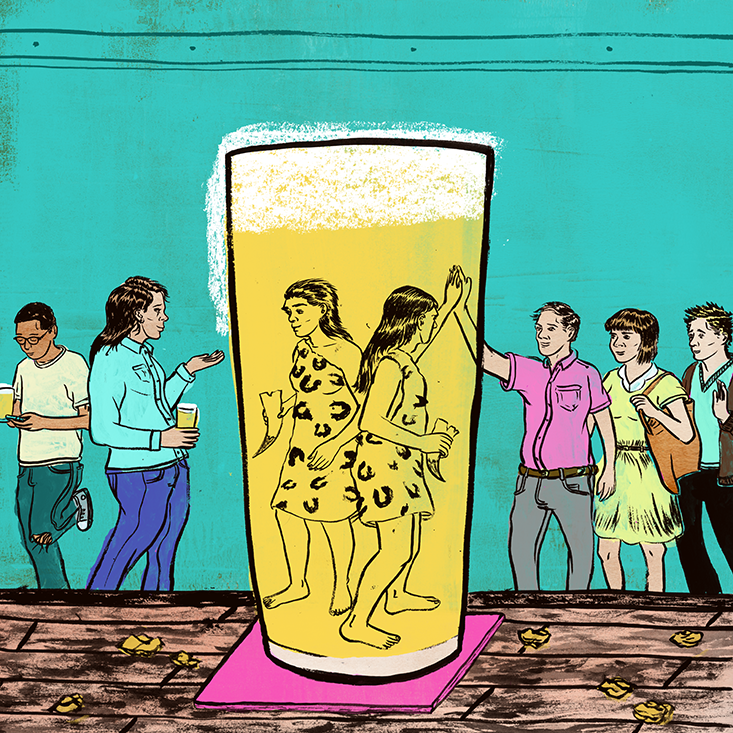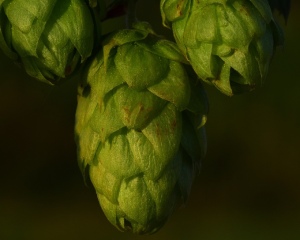

Beer Domesticated Man
Early man chose pints over pastry.
Wouldn’t you?
By Gloria Dawson
Sign up for our monthly newsletter!
The domestication of wild grains has played a major role in human evolution, facilitating the transition from a hunter-gatherer lifestyle to one based on agriculture. You might think that the grains were used for bread, which today represents a basic staple. But some scientists argue that it wasn’t bread that motivated our ancestors to start grain farming. It was beer. Man, they say, chose pints over pastry.
Beer has plenty to recommend it over bread. First, and most obviously, it is pleasant to drink. “Beer had all the same nutrients as bread, and it had one additional advantage,” argues Solomon H. Katz, an anthropology professor at the University of Pennsylvania. Namely, it gave early humans the same pleasant buzz it gives us. Patrick E. McGovern, the director of the Biomolecular Archaeology Project for Cuisine, Fermented Beverages, and Health at the University of Pennsylvania, goes even further. Beer, he says, was more nutritious than bread. It contains “more B vitamins and [more of the] essential amino acid lysine,” McGovern writes in his book, Uncorking the Past: the Quest for Wine, Beer, and Other Alcoholic Beverages. It was also safer to drink than water, because the fermentation process killed pathogenic microorganisms. “With a four to five percent alcohol content, beer is a potent mind-altering and medicinal substance,” McGovern says, adding that ancient brewers acted as medicine men.
In fact, McGovern has found that the ancients used beer as medicine. Working with the Abramson Cancer Center of the University of Pennsylvania, McGovern discovered traces of sage and thyme in ancient Egyptian jars. Luteolin, which is in sage, and ursolic acid, which is in thyme, both have anti-cancer properties. Similarly, artemisinin and isoscopolein from wormwood fight cancer, and were found in ancient Chinese rice wine. “The ancient fermented beverages constituted the universal medicine of humankind before the advent of synthetic medicines,” McGovern says.

Beer also played an important societal role in bonding early communities together. It was popular at religious ceremonies, communal events, and celebrations. Brian Hayden, an archaeology professor at Simon Fraser University in Canada, believes that communal feasting fostered social bonding—and lots of beer was consumed during those feasts. Moreover, beer was thought to be a necessary component in the afterlife—throughout the Middle East, the dead were buried with jugs of frothy refreshments. It was even used as currency—in Egypt, the pyramid workers were paid in beer.
The beer thesis is not universally accepted, however, and the debate over its truth goes back to the 1950s. It was around then that Robert Braidwood, a leading scholar in Middle East prehistory at The University of Chicago, discovered sickles and hollow casts of grain in clay in the early settlements of the Natufians, who from 13,000 to 9,000 B.C. inhabited a region in the Eastern Mediterranean which is now Syria, Jordan, and Israel. Braidwood argued that domestication of wild barley motivated early humans to build permanent homes and switch to a sedentary way of life. Others have since extended this argument.
Beer was thought to be a necessary component in the afterlife.
The great advantage of grain is that it didn’t spoil like fruit or berries, and could be kept for months and used as needed. That motivated our ancestors to build permanent structures to store their grains and homes close to their fields—which in turn led to the creation of villages. Archeologists have found stone silos dating from the Neolithic to the Bronze Age at sites in the Middle East.
Braidwood believed Natufians used the grain as food, and not for fermentation. But his work lead to a symposium titled “Did Man Once Live on Beer Alone?” Braidwood’s main opponent, Jonathan Sauer, a botanist at the University of Wisconsin, took a firm pro-beer stand. Sauer argued that growing grain with the primitive tools Natufians had would gain them a “pitifully small return of grain for their labor.” Natufians had to have been motivated by something more rewarding than mere food, Sauer believed. “Thirst rather than hunger may have been the stimulus behind the origin of small grain agriculture,” he said.
The symposium came to little consensus, but the debate continued. In the 1980s, Katz concluded from his own research that there was little evidence of bread’s popularity among the ancient tribes of the Middle East, particularly the Levant. To bolster his claim, Katz used a well-preserved sample of carbonized plant remains from about 7,000 to 6,000 B.C. recovered from the Ali Kosh site in southwestern Iran, where only 3.4 percent of the plants were domesticated cereals. If cereals didn’t make up a large part of early humans’ diet, what motivated them to begin to farm these grains? Katz argued they were farming and storing the grain to make beer.
Today, the earliest chemical evidence of barley-based beer is at the Godin Tepe archaeological site near the Iran and Iraq border, and dates back to 3,500 B.C. But scientists believe that grain-based fermented drinks have a much longer history than that, and were used around the world. “It isn’t just wheat and barley in the Middle East,” says McGovern. “It’s rice in China—rice wine was made from grain, similar to beer. It’s corn in the new world—Chicha is made from corn.”
“Thirst rather than hunger may have been the stimulus behind the origin of small grain agriculture.”
How did man originally discover beer? McGovern and Katz theorize that man first learned to make some sort of gruel from barley. Then, natural yeast, likely supplied by insects, would have fermented the gruel, leading to a primitive form of a beer. Beer was actually easier to make than bread. Once early humans sipped these ancient suds—whether barley, corn, or rice-based—they began cultivating grain, becoming sedentary creatures. “All of these grains could have jump-started civilization as we know it because you really have to stick around the whole year to take care of your plants,” McGovern says.
In 2010, Hayden and his colleagues set off to prove that the primitive tools of the Paleolithic era, such as mortar and pestle, were sufficient for brewing. The team created three different types of beer using the ancient grains—einkorn wheat, rye, and barley. “They all tasted a bit bland,” Hayden admits, but the brews had about 2.5 percent alcohol content—enough to pique early man’s interest.
“The question is really a no-brainer,” McGovern writes. “If you had to choose today, which would it be: bread or beer?”
Gloria Dawson is a journalist based in New York City, where she writes about science, food, and other topics. Her writing has appeared in The Wall Street Journal, National Geographic online, Modern Farmer, and Quartz, among other publications.
Illustrations by Daniel Fishel
This article previously appeared in Nautilus.
Plantings
Issue 39 – September 2024

The Art of the Brew: Exploring Hops and Other Plant Ingredients That Define Beer
By Gayil Nalls

Beyond the Brew: The Medicinal Power of Hops
By Ian Sleat

Viriditas: Musings on Magical Plants
By Margaux Crump

Plants, Psychodiversity, and the Paranormal
By Jake Eshelman

Inside the Floral Mind: A Conversation with Kreetta Järvenpää
By Gayil Nalls

Eat More Plants Recipes:
Raspberry Balsamic Dressing
By Diane Reiss
By Actor Matthew Modine

As Ireland transitions from the rich, smoky scent of peat-burning to a more sustainable future, its olfactory heritage is evolving. What will become the next iconic aromatic symbol of Ireland?
Click to watch the documentary trailer.

